Local business owners know digital marketing is critical. Unfortunately, many don’t sustain growth because they cannot maintain consistency or because they run out of ideas. The good news is, effective digital marketing is a beautiful mix of search engine optimization, pay-per-click marketing, content marketing, social media advertising, and more—and with ever-changing trends, there are always ways to come up with new ideas.
Yet as a business owner, it can be hard to come up with those new ideas. That’s why we’ve created this guide, which will cover local marketing suggestions and tips in four overarching categories:
- Local Facebook and Google advertising
- Local listings and review sites
- Local SEO
- Social media marketing
- Email marketing
- Community-based marketing
Some of these strategies are tried and true, while others may be new to you (rhyme not intentional, but we’ll go with it). The point is, there is something in here for everyone, whether you’re a rookie local marketer or a more seasoned and savvy specialist.
Effective local marketing ideas: advertising
Small businesses often have a small budget, so it might seem strange to have this as the first and foremost grouping of local marketing ideas. The truth is, thanks to the advanced targeting capabilities of online ads, they are a cost-effective way to get qualified exposure for your local business. The key is to do it right. Here are nine ideas and suggestions to use it to get a solid ROI on your advertising spend.
1. Run Google Ads
Google, one of the foremost search engines in the world, allows you to target potential customers in your local area specifically with pay-per-click ads. With this platform, you can run the classic search engine result Google Ad, Google Local Services Ads (Google LSA tips here), Google Shopping Ads, and more.
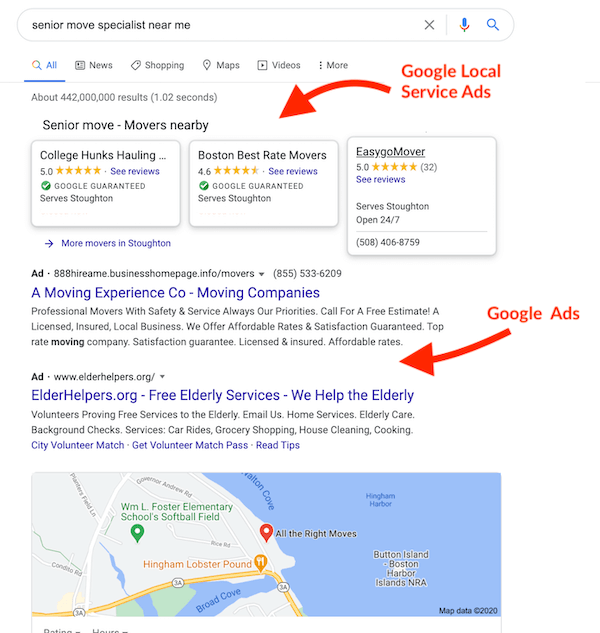
A higher volume of inquiries and increased sales are just two of many benefits of running Google Ads. A well-thought-out ad strategy can also yield long-term results that are less tangible, such as improved brand awareness and brand recognition, which often leads to referrals and sales down the road.To learn more, check out:
2. Set up detailed radius location targeting in Google Ads
Below is a simple explanation of Google Ads radius targeting.
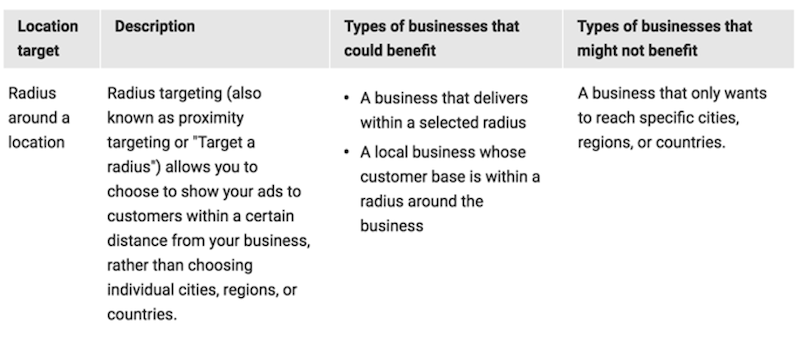
You might think you can set the target 2-5 miles around your store and then kick back…but not so fast! Taking advantage of the radius targeting feature along with location bid adjustments is what will turn your Google Ads from doing well to, well, crushing it. Here’s how to set up radius targeting in Google Ads:
Step 1: Create your locations
Let’s say you own a coffee shop in Irvine, CA, and let’s say that consumers are only willing to drive up to five miles to visit the store.
- Go to settings at the campaign level > all settings > edit locations > advanced search > radius targeting.
- Type in your address and select search.
- Add locations for a 1, 2, 3, 4, and 5 mile radius.
This is what the targeting map should look like when you are finished:
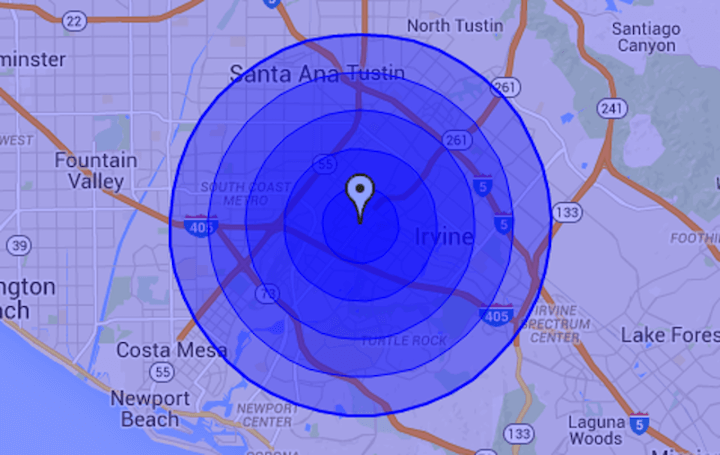
You know you are doing something right when your targeting is, in fact, a target.
Step 2: Collect data
The most important part of this Google Ads optimization strategy is using data to make your decisions. Now that the locations are placed in the campaign, you must give them time to collect clicks and more importantly, conversion data. Once your data reaches a significant level, you will then be able to perform the formula in step three and enter bid adjustments.
Step 3: Set location bid adjustments
A location bid adjustment is the percentage you would like to adjust your bids for a given location. You can set lower bids with negative numbers or raise bids with positive numbers.
To input these location bid adjustments, go to campaign settings > locations tab. Here you will see all of the radius locations that were just created in step one along with their performance data. You will notice a bid adjustment column (you will be using that one).
Here is the formula that you should use to create your bid adjustments for each location:
Location Conversion Rate / Average Conversion Rate – 1 = Bid Adjustment
Bid adjustment formula:
Location Conversion Rate / Average Conversion Rate – 1 = Bid Adjustment
An important thing to note is that bid adjustments will layer for a location within another location(s). For example, ads showing in the 1-mile radius will have the 2, 3, 4, and 5-mile radius bid adjustments added up. Here is an example of what actual bid adjustments will look like vs. the original adjustments that you will get from the formula above.
- Formula Bid Adjustments: 1 mile: 50%, 2 mile 35%, 3 mile 20%, 4 mile 10%, 5 mile 0%
- Actual Bid Adjustments: 1 mile: 15%, 2 mile 15%, 3 mile 10%, 4 mile 10%, 5 mile 0%
No conversion data? First off, shame on you! The best thing you can do is go with the assumption that the further someone is from your store, the less likely they are to visit. With that, don’t set a bid adjustment for your 1-mile radius, and gradually scale negative bid adjustments for 2, 3, 4 and 5 miles.
✅ Free Guide: The Best Ways to Promote Your Business (With or Without Money!)
3. Run local Facebook Ads
Running local Facebook ads in conjunction with Google Ads will even further facilitate sustained growth for your small business. Not only can social media ads increase sales; they can also increase consumers’ familiarity with your business over time. As they scroll through their feeds and perform searches on Google and see your business more and more, when the time comes that they need your services, your business is likely to be the one they call.

Now, you’re not alone if you are asking yourself (or your agency) “Do you really believe our target market is on Facebook?” The answer is YES. Whether you are B2B or B2C, you are still advertising to people and frankly, people love consuming content on Facebook. Below are the various objectives for advertising on Facebook. Website Clicks, Brand Awareness, and Local Awareness Ads are your best bet.
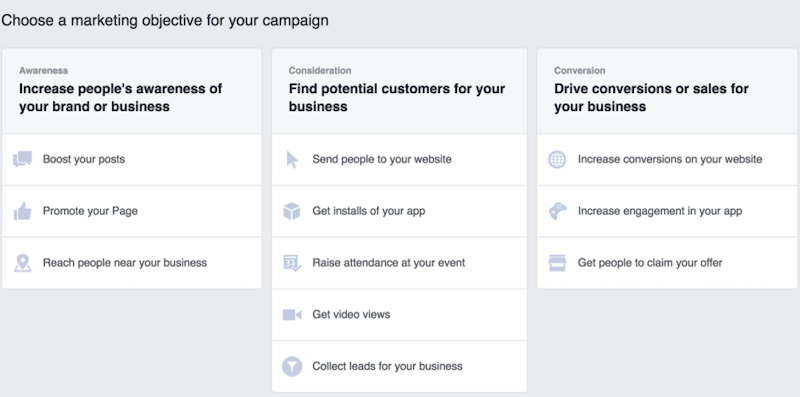
4. Show approximate distance from your store in your mobile social ads
As a local business, you have an advantage over national chains: They cannot, at scale, create hyper-local ads for each of their locations. Here are some tips to help your mobile ad copy successfully generate leads for your local business:
- Use Google Search Console to find new ad group opportunities based on what’s driving search impressions.
- Try including your Zip Code in the ad headline.
- Talk about distance to your location.
- Localize call outs and extensions.
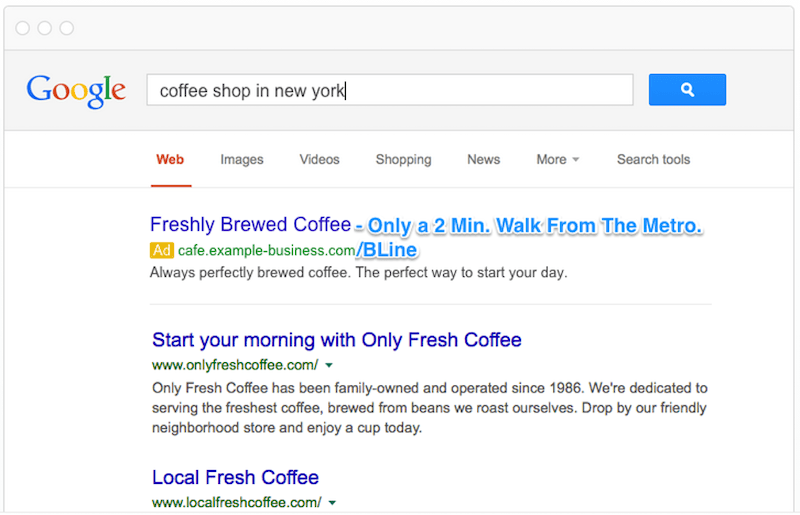
5. Build custom landing pages for every campaign
Countless local businesses throw money down the drain by not tracking conversions or building local landing pages. Ideally, each of your Google Ads campaigns should have a simple flow chart:
Click Ad > Go to Relevant Landing Page > Convert
Each of your Google Ads campaigns should follow this simple flow chart:
Click Ad > Go to Relevant Landing Page > Convert
The key tips to keep in mind when developing a landing page for a local audience are:
- Include only one clear call to action.
- Use a descriptive hero image that complements your value proposition.
- Answer your audience’s top questions to help them feel confident in moving forward.
- Make sure your contact number is click-to-call.
- Use sticky menus to keep important information and the CTA visible at all times.
- Test, test, test your local landing pages.
Here’s an example of a landing page that follows the above guidelines:

6. Use remarketing to generate reviews
Receiving and responding to reviews is one of the best things you can do for your business. Customers love you! Unfortunately, their memory can be poor and sometimes they just don’t remember to leave you those coveted 5-star reviews. Here is how to use remarketing to generate more reviews.

- Set up a confirmation or thank you page when people fill out a form or complete an event in your Google Analytics (GA).
- Add a remarketing tracking code to your confirmation page and set up the list in GA so that you can tag customers who visit that URL.
- Then you can create a simple display ad that says “Love us? Leave us a Review on Google! (Or the platform of your choice).
7. Don’t underestimate the power of LinkedIn
While social platforms like Facebook and Instagram remain popular among local marketers—and for good reasons—Clegg called LinkedIn “a potent platform for local businesses looking to expand their reach.”
That’s in part because LinkedIn outreach can deliver enhanced results when combined with emails. For one client, Clegg added 400 emails per month and scheduled 40 qualified sales calls per month as a result of implementing this tactic.
8. Try third-person ad copy instead of talking about yourself
Ever wonder how you can cut through the noise among other Google Ads? Try talking in the third person. We have experimented and seen higher CTR’s in ad copy that contains language that speaks to the customer in the third person. Here are some examples:
- “We Hired Them To Do Our AC and It Was Perfect.”
- “They Truly Are OC’s Best Plumber”
- “I Am a Raving Fan After Their Customer Service. You Need to Try Them.”
By using language like this, your ad will immediately stand out from the competition and you can start to build up your CTR’s.
Our process is simple: Go to your Yelp or Google My Business account, read reviews from customers, copy and use in your Google Ads copy; and as always, test and re-test!
9. Leverage call-only ads
If you are a local service business driving sales through phone calls, and if landing pages aren’t really your thing (even though they should be…) then call-only ads could be a lifesaver.

Call-only ads allow you to completely avoid the need for a landing page or a “leaky funnel.” If you do not have money for an ad team or custom landing pages, then call-only ads give you a way to advertise directly to your customer with a singular focus: customers and leads calling you.
Be wary though: you will get calls that are not entirely qualified, so make sure to leverage amazing ad copy that clearly allows your target market to self-identify with your offer. Here are some examples:
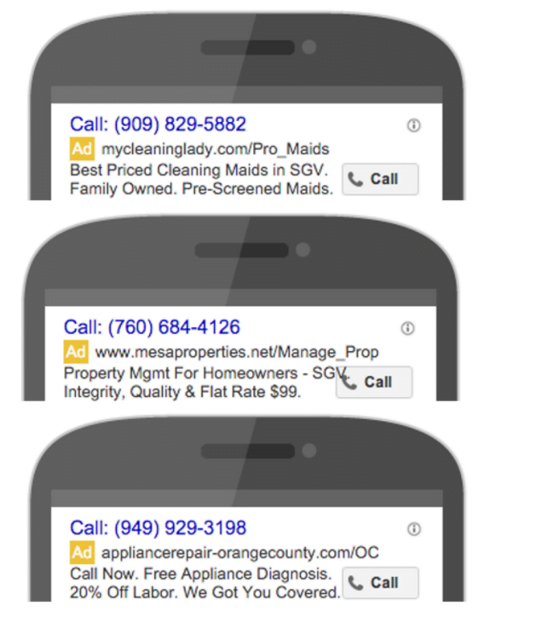
10. Test store-front images in your display and retargeting ads
Big picture, if you are a local business that thrives on foot traffic you want to start to create a correlation between your online presence and your physical location. You want to stand out in your advertising environment so that consumers, when driving or walking by your location, will think “Hey, I’ve seen that place before.” While copy like “Swing By Today” is catchy and needed, nothing ties the physical and the virtual together like a photo of your actual location.
Effective local marketing ideas: listings
Online review sites and local business directories sites such as Yelp, Merchant Circle, and Google My Business enable people to identify and learn about businesses in a specific area. Customers use these sites to find businesses where they live, where they are visiting, and to review good service. In order to use review sites and directories for your local online marketing, you need to get listed, encourage reviews, and monitor your listing. Here’s the breakdown:
11. Get listed
When creating your listing on these sites, be as detailed as possible, and make sure your information is consistent across listings. You want people to be able to use these sites to not only discover your business, but also to learn about, engage with, and become a customer of your business. If it is difficult for people to get to your website, find your address, or call you from your online directory listing, then you are likely missing out on new customers.
12. Prioritize your Google business listing, in particular
Every year, Google improves its local search capabilities more and more. Consumers rely on this search engine to find businesses close to them. If you want to get found by customers in your local area, you need to make sure you’re showing up on Google Maps results as well as the local results section of Google Search. How do you do that? With a Google Business Profile, which is the official term for a Google business listing. This free listing will not only give you greater visibility in local search, but it will also help you to obtain more customers. This is because the listing contains everything a consumer needs in order to make a decision about and even engage with your business.
📍 Are your listings optimized for local search? Find out with our Free Business Listings Grader!
13. Select your category
How important are listing categories, you might ask? They are critical—and here’s why. For one, if you advertise on Yelp, the queries that your ads show up for are determined by the categories you choose.
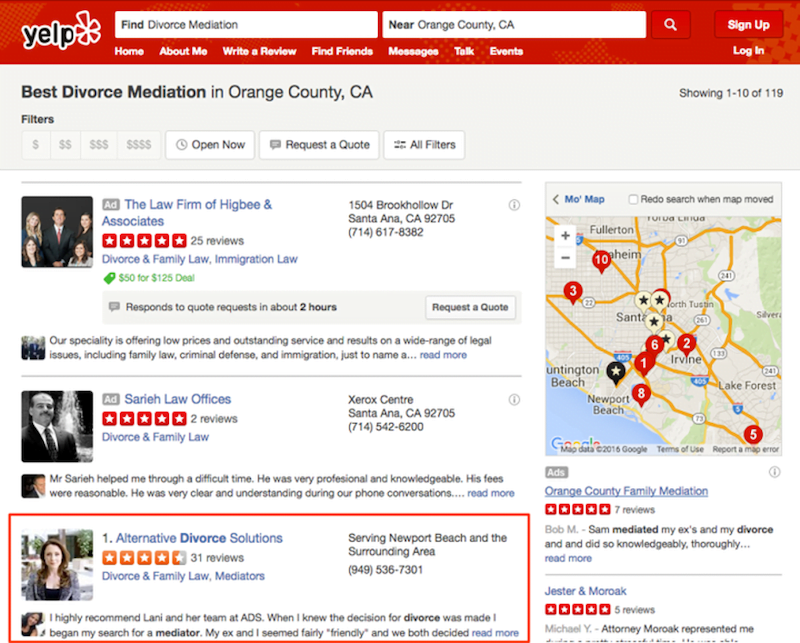
Furthermore, where your listing ranks organically on Google is also influenced by your Yelp categories. For example, in the image below, Alternative Divorce Solutions was able to move up to the number one result in a Yelp search for “divorce mediation” simply by listing their business under “Divorce & Family Law” as a category.
The importance of this spans outside of Yelp though! Look at the number one organic result in Google (under local results, which we’ll get to next) for “divorce mediation”:
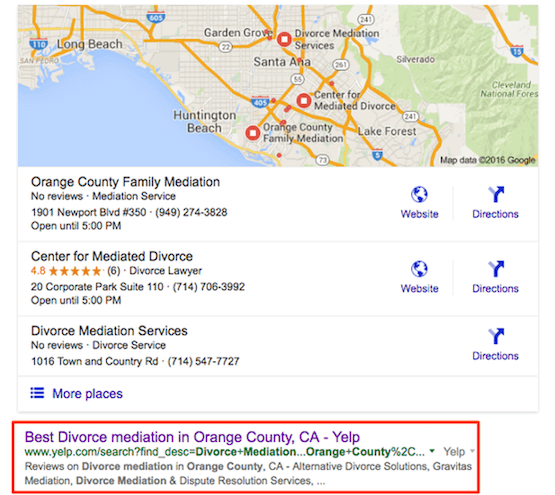
Yep, it’s Yelp. But if you’re included in that list, you’re on the first page of Google. So, by simply getting your Yelp categories correct you can start to immediately impact your lead volume.
This also means that if you pay for ads and don’t want to advertise on certain keywords, removing categories is critical as well. (Think of this like negative keywords.)
RELATED: 85 Profitable Small Business Ideas Worth Trying
14. Optimize your Google Business Profile
Choosing a category is important for any listing, but especially your Google Business Profile. It’s also one of several optimizations you should do to improve the efficacy of your Google listing. Just as with ads and websites, Google ranks Business Profiles according to their relevancy to the search term and overall quality. This means that by optimizing your Business Profile, you can rank higher in local search, show up for more search terms, stand out from competitors, and even win more customers. To optimize your Google Business Profile, create a Google My Business account so you can access and manage the information in your listing. All of the attractive information you supply in your account dashboard will then populate in your Business Profile to boost its quality—and therefore your visibility in local search.
15. Monitor and maintain your directory listings
Once you set up your directory listings, you can sit back and relax, right? Well, not quite. If there are any changes in your business, even as small as a suite number, you’ll need to update your listing. If people obtain inaccurate or out-of-date information about your business, they will not be able engage with it, and may even lose trust in your business. It’s also important to monitor your listings to respond to comments and reviews from customers. It’s a good idea to occasionally Google your business to make sure your listing is accurate.
Brought to you by

Ready to grow your business?
Unlock the results you’re looking for with technology-backed solutions designed for small businesses and agencies.
16. Encourage reviews
In addition to accessing your website and contacting you, potential customers will also use what other people say in order to learn about your business. If your business shows up in a directory and there are no reviews, they are likely to turn to a competitor who has reviews. Optimize your local online marketing by asking customers to write good online reviews for these directories and make it easy for them to do so. Check out our examples of personally asking for a review here.
17. Avoid “not recommended” reviews and Yelp filters
While it is essential to have a review strategy, there are some nuances around reviews to pay attention to for different platforms. For example, on Yelp, nothing is more irritating than reviews you rightfully earned going to the “not recommended” category or getting filtered out entirely. To save you time and pain, local marketing expert Mike Blumethal has a tactic to avoid this:
- Do not send clients a direct link to your page. Yelp can see this and detect that you are asking for a review. Instead, have them type “[your business name] Yelp” into Google so they can arrive at the page organically.
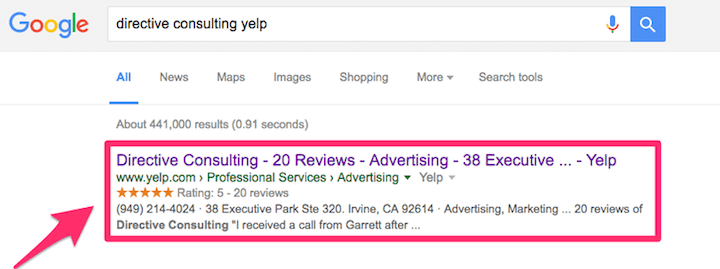
- Do not send email blasts to large groups asking for reviews (a large injection of reviews raises alerts).
- Do not have clients review the company from your place of business (gets filtered if reviews are coming from the same IP address).
- Do not send invites through the “Find Friends” feature. Identify them with the feature then reach out on Facebook or email (personally) to ask for a review.
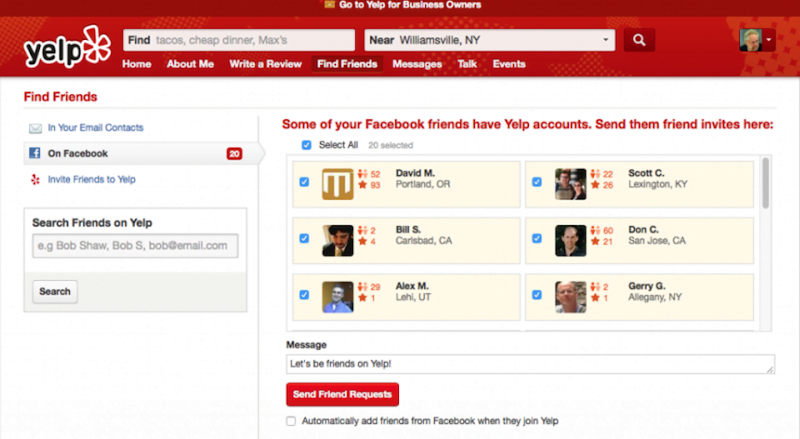
Effective local marketing ideas: local SEO
Listings are one of the fundamentals of local SEO, which is a set of practices to help your business rank higher for local searches on Google and other search engines. Let’s cover a few more local SEO tactics that can help you gain exposure for your local business to the right audience.
18. Create service area hubs and individual location pages to boost rankings
As a service-based business, you should have a unique service page for each of the core neighborhoods you serve. This way you can customize each page for the qualities, services, and traits specific to that location and each page will have a chance to rank organically for search queries like [your service] in [your location].
In addition, having the location-based pages in your top navigation, as with the example below, can improve your internal linking structure, which Google likes, which can in turn improve your rank. It also helps users to find the location most applicable to them more easily.
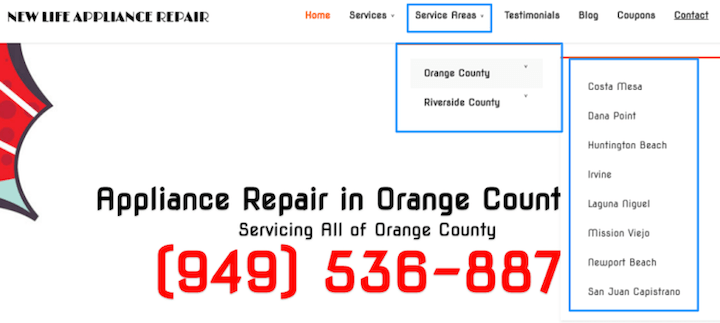
19. Add relevant local info to your location pages using Wikipedia
Crafting killer local pages is more of an art than a science. Beyond clarity and design, the relevance of the content on your page is hugely important. A great way to establish this relevance is by linking out.
Linking out to relevant local information is crucial in Google’s understanding of what you are associated with locally. To come up with ideas, we search: “city name + wikipedia” to come up with locally relevant ideas and talk about it in our page.
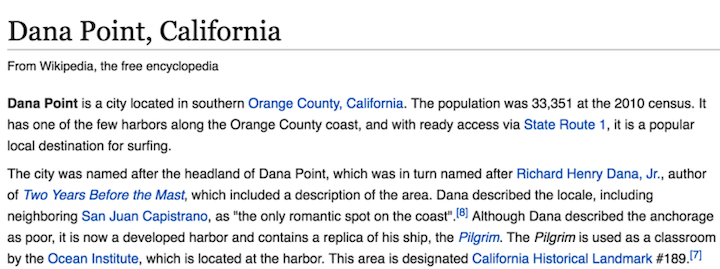
Here’s the basic template we follow:
- Keyword + city in title
- Talk about your history in the city and things you’ve been involved with in the community: link out.
- Talk about relevant partners or associated businesses. If you are a plumber talk about the different suppliers you use in the area. If you are a coffee shop talk about the places you buy your beans from.
- Talk about things that are relevant to what you do in your area. If you are a national lawyer, talk about the laws that are unique to that state. Here’s an example.
The key is that your page is useful, relevant, and builds a local bond with your searcher.
20. Create diversified local content
Geo-targeted content like emails and texts can also be powerful tools.
“Most importantly, producing consistent, high-quality local content tailored to the area and offering real value to nearby searchers is what can propel SEO success for local businesses in the ever-evolving local search landscape,” said Lyn Collanto, marketing specialist at SEO agency KBA Web. “Focusing initiatives around these types of local marketing strategies and trends will yield the best results.”
21. Don’t forget voice search optimization
In addition to local SEO basics, businesses should also integrate natural language processing to capitalize on voice queries.
“This involves utilizing conversational, long-tail keywords in content optimization, leading to a broader range of search visibility and potential customer attraction,” said Ken Fortney, CEO of SEO firm That Local Pack.
For example, instead of targeting “Italian restaurants,” businesses could use “family-friendly Italian restaurant in Boston.”
“This hyper-personalization targets the niche audience directly and increases conversion probability,” added Gianluca Ferruggia, general manager of B2B marketplace DesignRush.
And don’t forget Schema markup.
“Optimizing for local pack rankings with precise location-based keywords and building localized links from directory listings and community websites is key,” said Lyn Collanto, marketing specialist at SEO agency KBA Web. “As mobile and voice search continue to rise, enhancing on-site elements like click-to-call and direction links will also be impactful.”
Local marketing ideas: social media
Ask anyone how to market your business and you can rest assured they’ll tell you to use social media. Even better social media marketing gives you tons of room for creativity. Let’s look at some ideas.
22. Promote your latest customer reviews on Facebook
Here’s a juicy stat from a BrightLocal consumer survey: 92% of consumers now read online reviews.
92% of consumers now read online reviews.
We already know our customers want to read reviews. The key is to make these customer reviews more accessible, and a great way to do this is by incorporating them into your advertising. By leveraging Facebook advertising, you can quickly spread brand awareness and show off your stellar local reputation.
Here’s an example of a Facebook ad featuring a customer testimonial:

If you are struggling to get your images approved by Facebook, use this tool to test them. Then you can use this tool from Buffer for customizing your image and adding the text overlay.
23. Run a contest or giveaway
A lot of things may change, but one remains the same: people love free stuff! Therefore, a great way to attract locals to your business is to run a contest or giveaway. You could promote it through social media, email, your website, or even the local paper or a nearby radio station. To get people through your doors, you might even require in-store pickup or redemption. For example, you could use this model: “The first [number] customers to stop by today will get a free [product or service]!”
24. Automate your social media to join in on conversations in your shop
Staying up-to-date with your customers’ conversations on social media can be tough if you run a local business with foot traffic.. To help you out, we came up with a way to automate social media for you.

We made it simple for non-programmers like us and it only takes a Zapier and Twitter account to set it up.
The idea is that if someone in your location tweets something with your brand or your product’s name in it that your own Twitter account can respond to them with a variety of responses. For full details on automating social media, click here!
25. Use Facebook events
Whenever you have an event, create a Facebook event for it and send out invitations. Hosting an event and making a Facebook event or even an ad for it will increase your event’s and business’s visibility and will help get more people interested in attending.
26. Post in Facebook Groups
Another way to use Facebook to get local customers is with Facebook Groups. Search Facebook for local groups including business networking groups, industry related groups, or even parent or yard sale groups! Joining groups that your target market is in and posting your content in them makes group members more likely to engage with your business. Just be careful not to only post your content. Show interest in others’ content, promote articles by other sources, and engage in two-way conversation.
27. Use location tags
Social media is a great way to create a buzz about your business. In order to get local customers, use a location tag when posting. A location tag puts your business on the map, making it easier for local customers to find your business on Facebook or Instagram. Click here to learn how to add a location on Instagram or Facebook.
28. Use local hashtags
An easy tool that you can use to attract more local customers is by using hashtags in addition to location tags on social media. When used correctly, you can engage local customers with your social media accounts and make your business more likely to be found by users browsing around. Use local hashtags for your city, state, or town. People searching and using local hashtags will be more likely to find your business this way.
In order to optimize your social media accounts for SEO, be sure to include your business’s name, website, and short description about what you do in your social media profiles. In terms of gaining local customers, adding your location on every social platform you use can help your business become even more visible to those in the area. Your location is just another keyword people can search for to put your business on the map.
29. Connect with local influencers
Do you know a blogger or local influencer in your geographic or niche community whom people trust? Get to know that person or group of people and offer them a free service or product. Getting someone with strong local influence to try your business means that they might endorse your product to their followers.
30. Engage with social media communities
In addition to advertising on social media, local businesses can use these platforms to drive community engagement.
“Social media platforms are increasingly becoming local hubs,” said Deepak Shukla, founder of SEO agency Pearl Lemon. “Engaging with the community by promoting local events, participating in local discussions, and showcasing community involvement can build a loyal local following.”
Effective local marketing ideas: in the community
Chances are, your small business is primarily, if not entirely, dependent on the support and patronage of your community. That being the case, you need to pay special attention to its members, investing in marketing that will bring them together, benefit them, and build trust.
31. Become a local sponsor
Could you sponsor a local sports team, hold a fundraiser for a local youth club or support some other project or organization? Doing so would put your business on the radars of people who are involved with (or at least aware of) those projects and organizations. This might just lead to more business for you.
32. Do some volunteer work in your local community
What if you’re not quite in a position to become a sponsor? You can still do some volunteer work within your community. No matter where you’re based, there’s surely something helpful you can do. You might consider helping out at local non-profit or charity event. This will give you the opportunity to meet and interact with locals and may also move the organizations you help to promote your business in some way.
33. Attend local farmer’s markets and trade shows
In many towns and cities across the country, community events are happening weekly. If your business is located in a metropolitan area, there are often craft and trade shows going on near you, too. Sign up for events you think your target audience will attend, and promote your business at these functions to the attendees. Local events draw local crowds, which can help your business gain more customers in the area. Be friendly, offer incentives for interacting with you and your business, and meet as many potential customers as you can.
34. Form a local partnership
Make it a practice to network with local business owners. As you do, you’ll learn about their products and services, as well as their core values, mission, and customer base. If you find that their businesses complement yours and you’re targeting a similar demographic, a partnership might be worth considering.
You can then think of creative ways to promote one another’s businesses. This can be an effective way to go because you’ll have the credibility and good reputation of your partners working in your favor. Plus, their “vote of confidence” will give consumers all the more reason to trust and do business with you.
Local partnerships will have the credibility and good reputation of your partners working in your favor.
35. Join your local Chamber of Commerce
There are many resources available today for local business owners. Have you considered registering with your local chamber of commerce? A chamber of commerce is one of many a sort of business network with a focus on furthering the interests of local businesses.
Regardless of whether you’ve heard of or considered joining this type of organization before now, one fact remains. You should register as soon as possible so you don’t miss out on any opportunities available to you as a member.
36. Build guides for local activities & promote them
What a great way to do local content! Instead of just creating content that talks about yourself or is “for keywords,” start building useful, location-based guides. The example below is from a coffee shop, which helps to build their brand and help them be a part of their community.
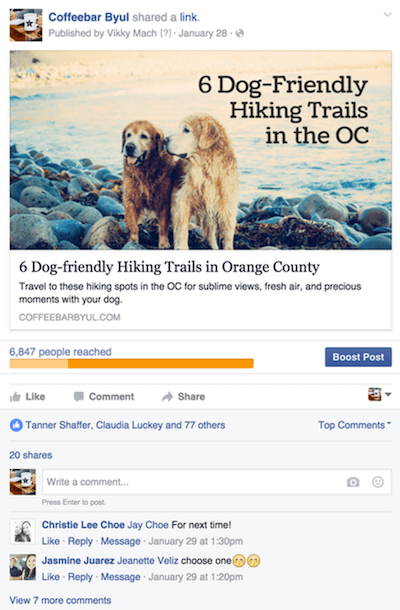
With small budgets (like $20) we’ve been able to use promoted posts on Facebook to get massive reach and increase brand queries associated with their primary keyword: “coffee shop irvine”. You and your team can do these exact same types of content.
Here’s a list of ideas to get you started:
- 10+ Dog Trails in (your city/county)
- Dates for Under $20 in (your city/county)
- Farmers’ Markets in (your city/county) That You Need to Visit This Weekend
- The Ultimate Guide To Craft Breweries in (your city/county)
37. Newspaper ads and contributions
Social media is huge, but that doesn’t mean that newspapers don’t still have a place in the world. If you have a local paper that people read, try advertising in it. Better yet, save the money and do something newsworthy. Tell the local paper about an event that you’re hosting and offer to provide inside access for a story! You could also ask to contribute a post useful to the community. Here are some guidelines for quality content.
38. Flyers
Flyers aren’t just for yard sales and finding your missing pet—they are another quick and easy local marketing strategy that can help attract more local customers. Print out as many copies as you think you’ll need and hand them out in an area with a lot of potential customers. Local supermarkets, festivals, and sporting arenas are good locations for getting your local community to learn more about your business.
Local marketing ideas: email marketing
Email marketing has been around forever, and for good reason: it works. In addition to using email to converse with clients, ask for reviews, and follow up with leads, you can also use it to keep existing customers interested and nurture leads into customers. Here are some email tips for local marketing.
39. Send locally-focused emails
Email is an effective way to keep in touch with past customers and gain new ones, especially for local businesses. Think about how you can make your emails more attention-grabbing with local content. You might try a monthly newsletter that also includes relevant updates about the community. Or maybe deals and discounts creatively named based on location-specific themes, such as street names or other community mainstays. You could also write free guides or blog posts with a local focus and distribute those via email. For example, a nutritionist could share a blog post on “Best Health Food Stores in the Chelmsford Area”, while a real estate agent could share a guide such as “Best Resources for Boston Home Buyers”.
Think about how you can make your emails more attention-grabbing with local content.
40. Offer emailed mobile coupons to track offline conversion intent
Offline conversion tracking is a daunting task and can often rely on the dependence of micro conversions (time on site, specific page visits, etc.). Lucky for you, we have the answer to all of your offline conversion tracking pains: Emailed mobile coupons! This is a coupon that the consumer can request via email and show on their phone when it’s time to purchase at your store.
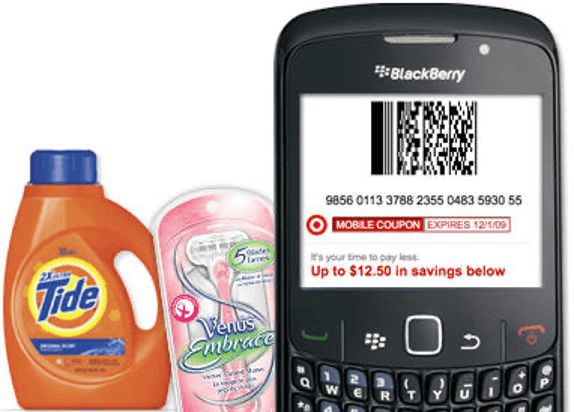
Adding an emailed mobile coupon to your site is a great way to track both conversion intention and execution. You can add your paid traffic tracking script to the coupon request action to easily track purchase intention.
If you would like to take things one step further, build a custom landing page for this emailed mobile coupon and only show it to your paid traffic. That way, you can attribute all of your in-store transactions using the coupon to your paid efforts.
More local marketing ideas
41. Encourage word-of-mouth marketing
Word of mouth is also a highly effective local marketing tactic. The best thing you can do to promote word-of-mouth in your local area, of course, is to provide outstanding customer service. You should also be proactive by asking for reviews, in person, via email, or on social media. One last idea is to package a solid offer up in a shareable email or social media post. If your audience members feel that someone they know could benefit as well, they’ll be happy to forward along to family and friends, increasing your business’s local exposure.
42. Distribute business cards, brochures, and flyers
Though we live in an online world, printed material is still widely successful with local marketing. Make sure your collateral is eye-catching, clearly explains briefly what you do or offer, and contains all necessary contact information. You can then set them out at your physical location, pass them out to potential customers and partners, or leave them in popular local go-to’s such as coffee shops.
These, too, will keep your business top of mind and may also end up in the hands of potential customers you previously hadn’t reached.
43. Offer referral incentives
Kill two birds with one stone by offering referral incentives such as discounts and other coveted perks. Not only do they keep past customers coming back to you, but they also reel in new ones. Need we mention that these new customers—the family, friends and professional connections of current buyers—may also refer you, increasing your reach even more? This is, without a doubt, one of the most rewarding local marketing tactics you could use!
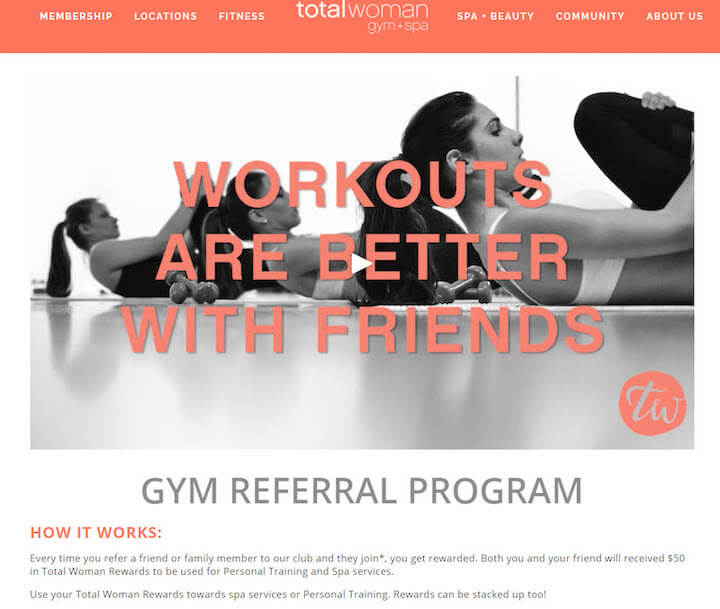
44. Create a “Get Directions” page and set views as a micro-conversion
If you are a local business, it can be difficult to tell if your online efforts are driving offline conversions. To help make your life easier, simply set your “get directions” page or tab as a destination URL goal in Google Analytics. With this type of data, you can build a somewhat reliable attribution model for your paid efforts.
More ideally, however, we recommend comparing advertising channel spends with overall revenue growth. So, when we spent $1,000 on Yelp compared to $500, how much more revenue did we make? Was it worth it? Start to notice trends and you can see where your dollar yields the greatest increase in marginal returns.
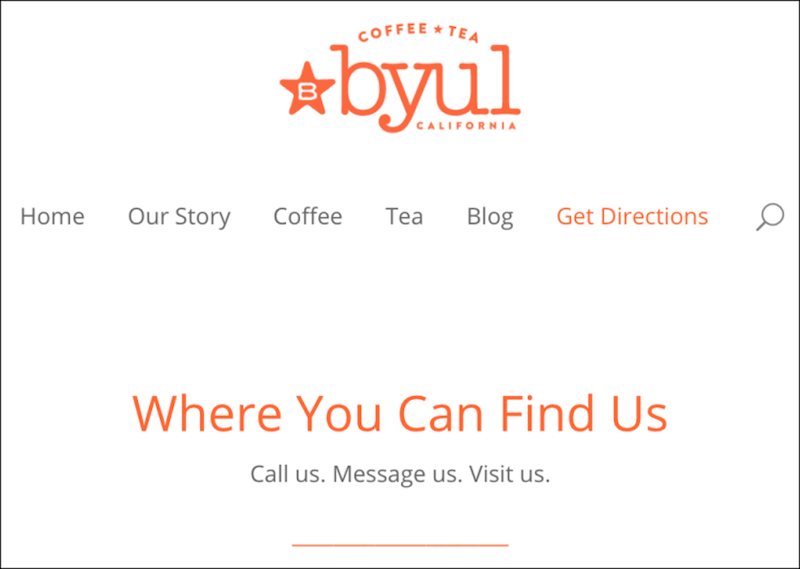
45. Create seasonal content
There are tons (and I mean tons) of observances and awareness causes that are allotted to specific months of the year. There’s Domestic Abuse Awareness Month, National Compliment Day, Financial Literacy Month, and the list goes on. These themes and observances give you the opportunity to add a touch of philanthropy, festiveness, and fun into your marketing content. Even better, you can really build a sense of community, which is huge for local businesses. Here are some monthly marketing ideas (with plenty more to come):
- 17+ Free and Creative September Marketing Ideas
- 21+ Free and Effective October Marketing Ideas
- 19 Simple Yet Superb November Marketing Ideas (with Examples)
- 20 Super-Festive December Marketing Ideas
- 15 January Marketing Ideas to Start the New Year with a Bang
- 20 Fabulous (and Affordable) February Marketing Ideas
46. Invest in video
Local businesses that want to take their content marketing efforts up a notch should consider video, which remains the format of choice across social media.
“This trend offers businesses new opportunities to creatively engage with their target audiences, revolutionizing how they connect with viewers,” said Zain Bin Zameer, senior link-building expert at Technology Ally. “Whether through product demos, brand stories, or educational tutorials, the impact of video content is set to reshape the marketing landscape for years to come.”
Small businesses should also experiment with formats like short-form or live videos to capitalize on platforms like TikTok and Reels.
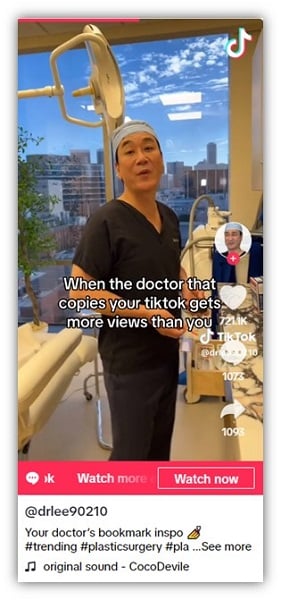
“These strategies will harness not only digital trends but also market shifts in consumer behavior and technological advancements,” said Dan Dillon CEO of CleanItSupply.com.
47. Use AI tools
While the benefits of video content are well-documented, high-quality video isn’t always affordable.
However, thanks to the advent of AI tools, we’re going to see further democratization of high-quality video content in 2024.
That’s according to Lucas Ochoa, CEO of Automat, who said, “What used to be an expensive and exclusive process is becoming more accessible and affordable. This shift won’t just level the playing field for local businesses but will also usher in a fresh wave of creativity and personalization in marketing communications.”
🤖 Want to use AI the right way? Free download >> Emergency Guide to AI in Marketing
Find the right local marketing mix for your business
The goal with all these local marketing ideas is that you are able to cut through the noise and stand out from your competitors. These creative advertising and marketing ideas should be tested and either put to rest or elevated into the hall of fame.







